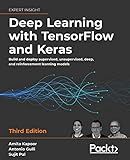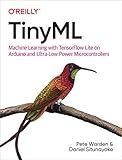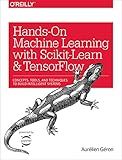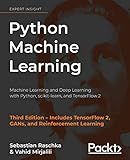Best TensorFlow Books to Buy in December 2025

Hands-On Machine Learning with Scikit-Learn, Keras, and TensorFlow



Deep Learning with TensorFlow and Keras: Build and deploy supervised, unsupervised, deep, and reinforcement learning models, 3rd Edition



TinyML: Machine Learning with TensorFlow Lite on Arduino and Ultra-Low-Power Microcontrollers



Hands-On Machine Learning with Scikit-Learn, Keras, and TensorFlow: Concepts, Tools, and Techniques to Build Intelligent Systems



Hands-On Machine Learning with Scikit-Learn and TensorFlow: Concepts, Tools, and Techniques to Build Intelligent Systems



Python Machine Learning: Machine Learning and Deep Learning with Python, scikit-learn, and TensorFlow 2, 3rd Edition



Learning Deep Learning: Theory and Practice of Neural Networks, Computer Vision, Natural Language Processing, and Transformers Using TensorFlow



Understanding Deep Learning: Building Machine Learning Systems with PyTorch and TensorFlow: From Neural Networks (CNN, DNN, GNN, RNN, ANN, LSTM, GAN) to Natural Language Processing (NLP)


To write an argmax function in TensorFlow, you can use the tf.argmax() function provided by the TensorFlow library. This function takes an input tensor and returns the indices of the maximum values along a specified axis. By default, the axis parameter is set to 0, which means that the function will return the index of the maximum value along the first axis of the input tensor. You can also specify a different axis if needed.
For example, if you have a tensor of shape (3, 4) and you want to find the index of the maximum value along the second axis, you can use the following code:
import tensorflow as tf
Create a sample tensor
tensor = tf.constant([[1, 2, 3, 4], [5, 6, 7, 8], [9, 10, 11, 12]])
Find the index of the maximum value along the second axis
argmax_index = tf.argmax(tensor, axis=1)
Create a TensorFlow session and run the code
with tf.Session() as sess: result = sess.run(argmax_index) print(result)
This will output the index of the maximum value in each row of the input tensor. In this example, the output will be [3 3 3], which indicates that the maximum values in each row are located at index 3. You can adjust the axis parameter as needed to find the argmax along a different axis.
How to troubleshoot issues with the argmax function in tensorflow?
There are a few steps you can take to troubleshoot issues with the argmax function in TensorFlow:
- Check the input data: Make sure that the input data you are providing to the argmax function is in the correct format and shape. The input data must be a tensorflow tensor or numpy array with the appropriate dimensions.
- Check the axis parameter: The argmax function takes an axis parameter that determines which axis to perform the operation on. Make sure that you are specifying the correct axis based on your data dimensions.
- Check for any NaN values: If there are any NaN values in your input data, it can cause issues with the argmax function. Make sure to handle or remove any NaN values before using the argmax function.
- Check the output: Verify the output of the argmax function to ensure it is returning the expected results. You can print out the output values and compare them to the expected output to identify any discrepancies.
- Use the tf.debugging.assert_equal function: This function can be used to compare the output of the argmax function to the expected output and raise an error if they do not match. This can help you identify any issues with the argmax function.
By following these steps and troubleshooting any potential issues, you should be able to resolve any issues with the argmax function in TensorFlow.
What is the best practice for naming an argmax function in tensorflow?
The best practice for naming an argmax function in TensorFlow is to use a clear and descriptive name that indicates its purpose and functionality. Some possible names for an argmax function could be:
- find_argmax
- calculate_argmax
- get_argmax
- argmax_tensor
- determine_argmax
It is important to choose a name that is intuitive and easy to understand for other developers who may be working with your code. Additionally, following the TensorFlow naming conventions and guidelines can help ensure consistency and clarity in your codebase.
How to test the argmax function to ensure correctness in tensorflow?
One way to test the argmax function in TensorFlow is to create a simple example with known outputs, and then compare the output of the argmax function with the expected output. Here is an example using TensorFlow's argmax function:
import tensorflow as tf
Create a simple example tensor
input_tensor = tf.constant([[1, 2, 3], [4, 5, 6]])
Get the argmax along the last dimension
output = tf.argmax(input_tensor, axis=-1)
Expected output: [2, 2]
expected_output = [2, 2]
Initialize TensorFlow session and run the output
with tf.Session() as sess: result = sess.run(output)
# Compare the result with expected output
assert (result == expected\_output).all(), "argmax function failed the test"
print("argmax function test passed")
This code snippet creates a simple 2x3 tensor and calculates the argmax along the last dimension. It then compares the output with the expected output [2, 2]. If the assertion passes, it means that the argmax function is working correctly.
